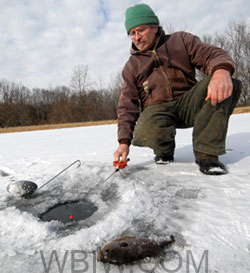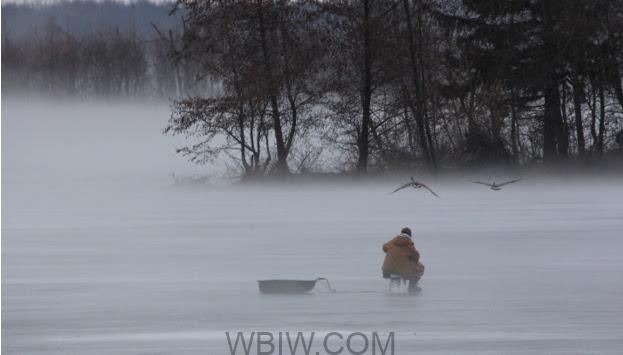
INDIANA – Seasons change but your fishing habits don’t have to as long as you have the right equipment. As Indiana’s waters cool, you can turn your attention to ice fishing.

Every winter, thousands of Hoosiers enjoy fishing, skating, hiking, or just sliding around on frozen ponds and lakes. And every year, people drown after falling through the ice. Like driving on snow, Hoosiers need to re-learn how to have safe fun on the ice.
If You Are Fishing:
- Drill your own test hole near shore. Your test hole should show at least a four-inch thickness of clear ice like you get from your freezer.
- Wear a life jacket for extra warmth and safety.
- Be aware of various ice strengths and qualities. One area of a pond may be a foot thick while another spot of ice may only be an inch thick.
- Ice strength can also change. Thick ice is rotten after rain. Old honey-combed ice, slush ice, or ice with a current under it is also dangerous. New ice is almost always stronger than old ice. Wind, waterfowl, and beavers can also keep areas of ice thin.
- Indiana law limits ice fishing holes to a diameter of twelve inches.
- Fishing shanties must have reflectors on each side so snowmobiles won’t crash into them at dusk or during snowstorms.
Use these guidelines to judge the safety of fresh solid ice
| Ice depth | Activity |
|---|---|
| One inch | STAY OFF |
| Four inches | Needed for safe ice fishing |
| Five inches | Needed for snowmobiling |
| Eight inches | Needed to support the weight of a car or light truck. |
| Ten inches | Needed to support a medium-weight truck. |

If you plan to ice fish, be sure to put safety first. Follow these tips for a safe and successful ice fishing season:
- Fish with a partner so that someone can call for help in case of an emergency.
- Carry ice picks to assist in pulling yourself out if you happen to fall through the ice.
- Wear ice cleats to avoid slipping and falling on the ice and possibly causing injury.
- Notify others where you will be fishing and when you expect to be home.
- Wear a flotation device and carry a rope in case of an emergency.
For more information on ice fishing, visit our Fishing Guide. Looking for places to fish? Visit DNR’s Where to Fish Map.



